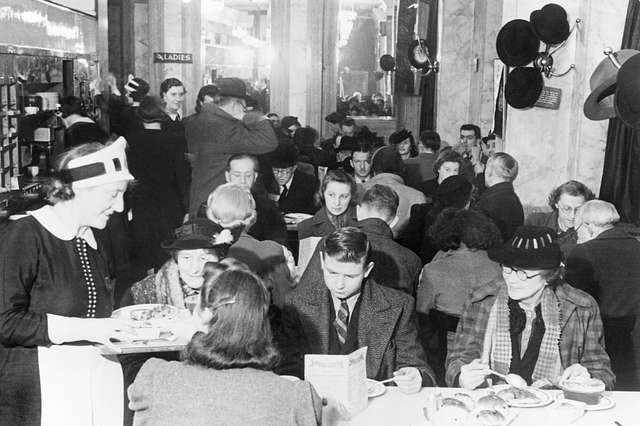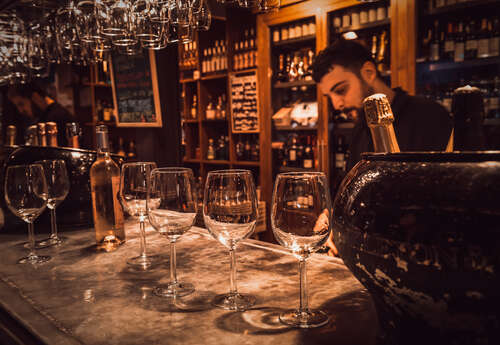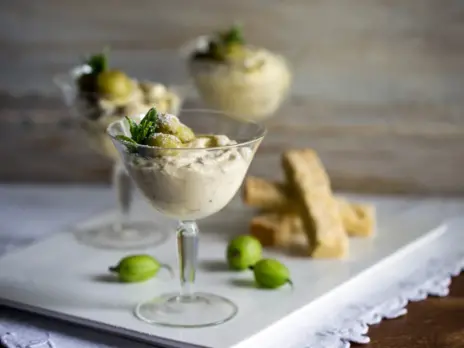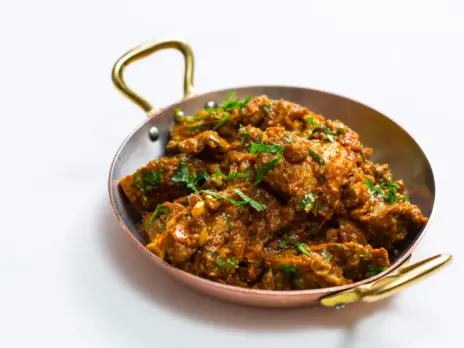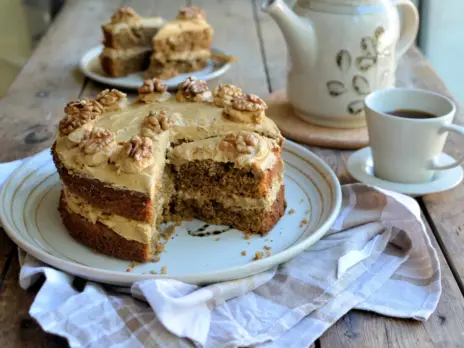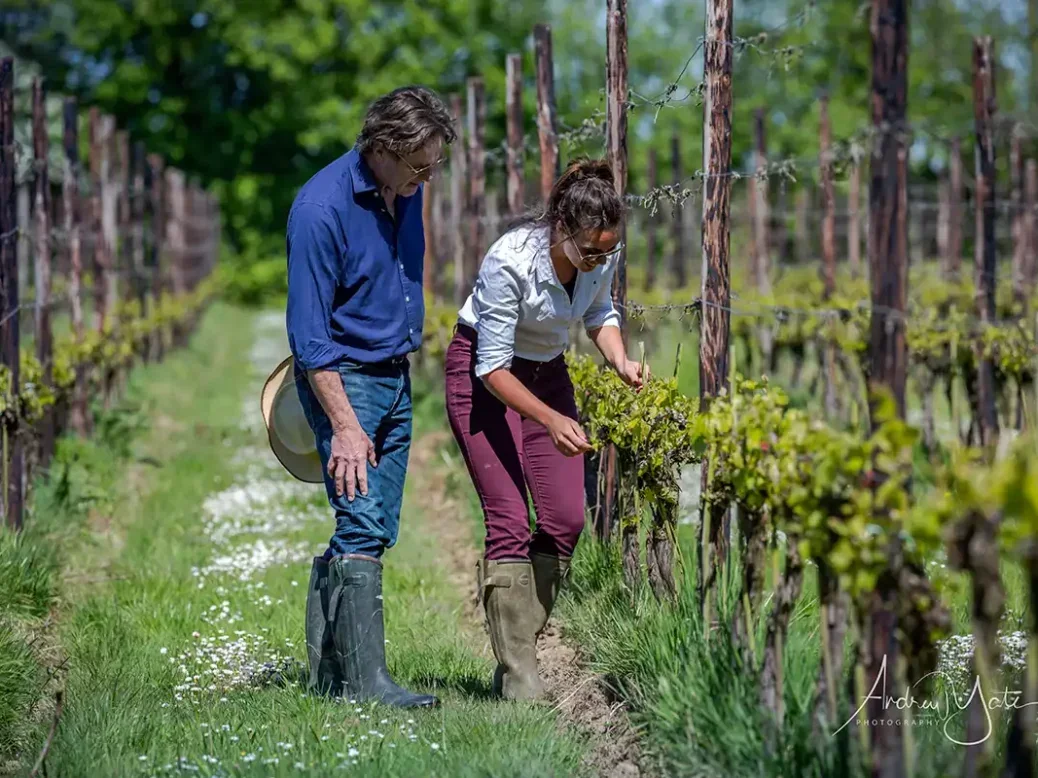
Margaret Rand meets Herbert Hall owner Nick Hall and winemaker Kirsty Smith.
Kent, in southeast England, has always been beautiful—and it still is. But it used to look rather different: There were hop fields everywhere, and what wasn’t given over to hops grew apples and pears and cherries. Nicholas Hall, owner of sparkling-wine maker Herbert Hall, remembers road signs in the spring pointing motorists toward the blossom tours. People came to Kent to see the fruit blossom.
The orchards now are far fewer, victims probably of British supermarkets’ relentless hammering of producers. There are huge solar farms where there used to be agriculture. The hop industry declined with the increased popularity of lager. There are still some hops, though, and you can still sometimes see the old sheds provided for the hop-pickers’ accommodation—there are some at Herbert Hall, disused for years and surely ripe for conversion into an Airbnb. Would you, Nick? “No,” he says firmly.
They are basic; a pointed reminder of how much richer we all are now. Hop-picking provided late-summer income for hundreds of families, who decamped from London and, says Nick, worked extremely hard and had a thoroughly jolly time. They were replaced by machines from the 1960s; then, lager became fashionable and the hop fields shrank. Nick remembers as a child being out on a tractor picking hops.
As for the apples, “a lot now are just carbon-capture,” he says. “They’re not even picked. They’re just wild trees with sheep underneath.” He shows me one such orchard, next door; the apples are copious, red, and fattening nicely. I consider adapting a line from Robert Frost: “I am all vine and he is apple orchard.” The grass and wildflowers grow abundantly between the rows. There are probably more butterflies than there would be if these apples had been sprayed to keep them looking pretty for the shops. But—what a waste of good food, while apples are shipped in from across the world. It was partly to get back to that Kent of his childhood that Nick started Herbert Hall. Vines in Kent are the new hops, the new orchards. But why Herbert?
Doing one thing as well as possible
Herbert Hall was Nick’s great-grandfather. In the late 19th century, he took on the tenancy of ten acres (4ha) near the village of Marden. Ten acres is not a lot: a couple of fields, more or less. He grew everything: apples, pears, plums, pigs, chickens… the lot. He used to put his produce on a cart and sell house-to-house, says Nick. But it was the chickens that made money: Herbert sold them to P&O; he bought his ten acres and then some more.
“I was never destined to be a farmer,” says Nick. He left at 17 and came back 25 years later to go to study at Plumpton College in East Sussex; in the meantime, his brother had inherited the family farm. What Nick established is a small, artisanal, single-estate business, organic but not certified, which 90% of the time consists of him and winemaker Kirsty Smith. (The rest of the time they get local volunteers in, who do a long morning’s work and then have a good lunch. Last harvest they had 80 volunteers.) “It’s the simplicity of doing one thing as well as possible,” he says. Between them, they do everything: tractor-driving, picking, sales. Kirsty is practical and loves the physicality of winemaking, the pumping-over, the getting down and dirty. She even treads some grapes herself, in a half-ton picking bin. Nick is less mechanically minded; he remembers early on, when the strimmer broke down and he was, naturally, shouting and swearing at it, his five-year-old son came along and fixed it. Okay…
His 25 years away from Kent were spent doing an English degree at King’s College London and a journalism course in Sheffield, followed by a stint at South London Press and then Marketing Week magazine, and then an arts setup in Deptford, London, working with studios to sell their work. It was an unintentional, unplanned career, he says. He missed the last module at Plumpton: “I could have been BA, BSc.” But what he does have is a combination of marketing know-how and a farming background that proved useful when it came to selling his own wine. “Keep the message the same; keep the branding the same. If you know who your customers should be, make sure the branding will appeal to them,” is how he describes it. The winery’s neat Art Deco-ish logo was done by a friend who had done designs for Black Sabbath—whose music he actually hated, so he did sharp, jagged designs for them. Nick wanted something clean and stylish, influenced by the evenings he had spent in his youth at Le Caprice, sitting cheaply at the bar because he didn’t have much money, but loving the glamour.
And there is the logo on the sign outside the winery, which has an entrance as improbable as any I have seen in England. There’s a rusty corrugated-iron hop shed, overgrown with ivy, and the bits that aren’t overgrown are derelict. It’s unpromising. Then you go through a little gate, and suddenly you’re in a garden with tables, umbrellas, and lavender, and vines beyond. It’s as though a switch has been flicked on—everything suddenly is cheerful and sociable and welcoming. There’s a bar here on summer weekends, and people can buy wine and bring their own picnics; and there’s the winery, too, which is small, with a few (used) oak barrels and steel tanks ranging from 675 liters to 2,500 liters.
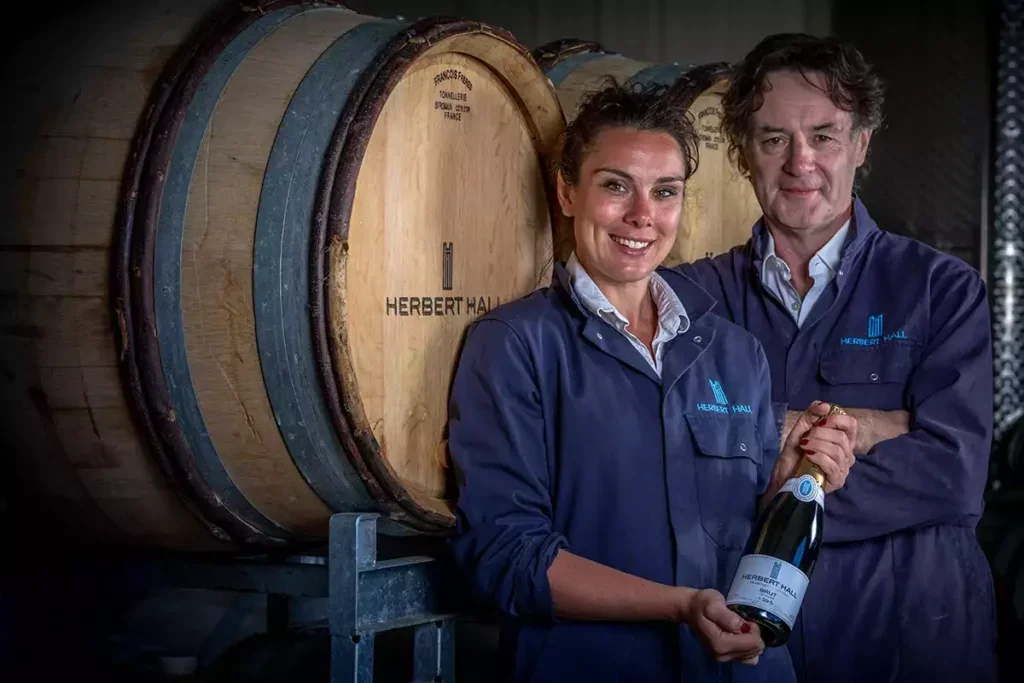
Artisanal single estate
The vines in front of the winery, just under 2.5 acres (1ha), were planted mostly because they were in front of the winery, says Nick. The main vineyard is across the road, on a south-facing slope with a gravel seam running through it; this was the land that Herbert Hall reckoned was the best, and earliest ripening. Apart from the gravel, the soil is Weald clay, quite heavy and hard to work; it gets solid and gluey when it’s wet, and it sets like concrete in drought. “It takes longer for vines to get established,” says Kirsty, “but they probably have really strong root systems.” Before they planted, they did a lot of subsoiling and loosening, and they put in drainage; the gravel part is better drained, anyway.
That first planting was 2007; the only other planting in 2017. Kirsty arrived in 2013, straight from Plumpton and experience in California; California taught her that “if you’re not born into the right family, or have a lot of money, there’s not much progression there, and you’ll be stuck in certain roles.”
She was at Herbert Hall on a fairly informal basis at first; she was still a student at Plumpton, and Peter Morgan, who taught her and had taught Nick, said they’d get on. Then the following year Nick launched a Young Winemaker of the Year award, which offered the winner the chance to make a wine at Herbert Hall. Their entry had to consist of a detailed protocol for how they would make such a wine—and if it was slightly off-piste, so much the better. The first winner was—well, Kirsty. Now they describe her 2014 Blanc de Blancs (it says “by Kirsty Smith” on the label) as the template, a precursor, and you can see why they might want to play it down now, since she promptly became Nick’s full-time winemaker, but honestly, the wine is a treat, and still young: creamy, tense, fine, and with just 2g/l of dosage. They repeated the competition a year later: “A huge success,” says Nick. “But the guy disappeared abroad and went to New York.”
The Blanc de Blancs is not part of the main range, which consists of just two wines: a Brut NV and a Vintage Rosé. The luxury of higher volumes now means that, as well as those two, they can make small amounts of other wines, as the year and the grapes suggest, maybe 500 or 1,000 bottles. The Blanc de Noirs 2016 is one such; just one François Frères barrel, disgorged in 2022—they leave such wines as long as the wines need—and released now. It’s rich and almost opulent, full of cocoa and red fruit, but sappy and almost crunchy, too. It’s also a rather darker color than the rosé, which is so pale that Nick says that the Wine Standards Board wasn’t totally happy with it, though he’s still not sure if it’s any of their business.
The only other wines are two half-bottles: 2021 Brut and 2021 Rosé, different to the other wines, with less lees aging and more dosage—12g/l. They’re a bit more solid, the dosage like a blanket over the finesse of the standard versions. But one can see that they would appeal to some consumers. When they do dosage trials, they move away from the winery and become consumers: “We become the person in the restaurant.” Neither likes cloying, oversweet wines. “We’re on the same page,” they say.
Nick has ten acres of vines now and won’t have more, “especially at the moment.” “It’s an interesting time for English sparkling,” says Kirsty. “Everyone’s going big.” “But we’re known as a small winery,” says Nick—indeed, until they put the sign outside on the road and opened the weekend bar, a lot of locals didn’t know they were there. “If we were bigger, we would need more people, and we’d need more outlets,” and that becomes a very different business. It’s all been self-financed so far, using family land: “I own one vineyard, and my brother owns all the other land, but it wasn’t being used and he said, ‘Go ahead.’ There’s not a lot of land around here that’s suitable… It gives us a living. It’s genuinely artisanal single-estate [wine], all done by hand, and that’s all we can do.”
Mostly it’s at top restaurants at the moment. When they first started, they got some good write-ups, which obviously helped, but Stephen Clark, late of Laurent-Perrier, took them to the Gavroche, and they got a listing. “And I thought, hey, this is easy,” says Nick. Then Le Caprice—scene of those youthful glasses at the bar—listed the wine, and Prince Charles (as he then was) was looking for an organic English sparkling for Highgrove, and they did that—and still do.
Not much has changed in the winemaking since the start. The purpose is balance—they’re both mad keen on balance. And the wines, all of them, have great poise, with delicacy underlined by tension. The malo is what has changed most. Nick wanted to be very purist at first, with no malo at all, which was fine in the first vintage, the hot 2009. The 2010 and 2011 vintages were more austere, and now Kirsty sets up a malo protocol for each vintage early on: “The grapes tell us what to do when they come in,” she says. It might be no malo, or a bit, or quite a lot, or total. The 2013 had 100% malo, and that was right for the year. The 2023 had none. The house style is thus fairly consistent, but they’re managing acidity early on rather than using dosage to do it: dosage is 5g/l in the Brut, 6g/l in the Rosé. And they haven’t chaptalized since 2017. “Every year is an expression of what happens here,” says Nick.
It’s a tiny corner of Kent, a microcosm of agricultural change. I am all vine and he is apple orchard.

